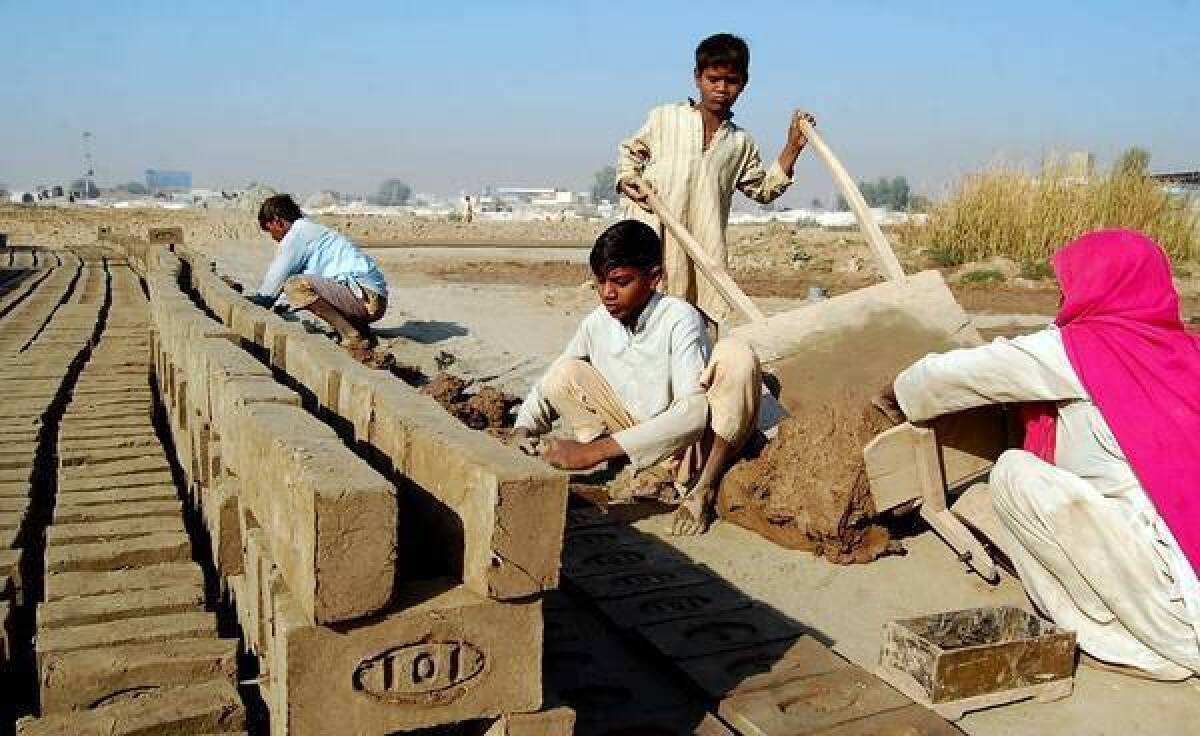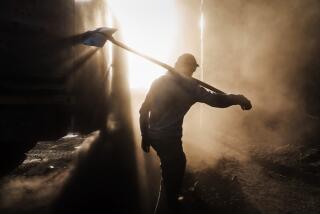Pakistan kiln laborers hemmed in by debts they can’t repay

MULTAN, Pakistan — The mounds of clay are so heavy that they have warped Shahbaz’s creaky wooden cart. The 10-year-old boy’s spindly arms struggle with the weight, about 45 pounds. He teeters as he wheels cartload after cartload to his mother, a waifish woman crouched on the ground who is turning the wet clay into bricks at a rate of three per minute.
A few feet away, 12-year-old Shahzad matches his mother brick for brick. Without the help of the two boys, their daily brick yield wouldn’t be high enough to feed a family of seven.
“I hate this,” says the mother, Nazira Bibi, slapping a clod of mud into the brick mold and flipping it over with a thump. “I hate the fact that my kids have to do this work, that they’re not in school. When I see other kids going to school, I wish my kids were those kids.
“But we’ve got no choice. If we don’t work, we don’t eat.”
The Pakistani Taliban’s brutal attack on teenage education activist Malala Yousafzai provided the world a window on the insurgent group’s long-running campaign against “un-Islamic” schools in the country’s northwest.
But in much of the rest of the country, one of the most entrenched barriers to education comes from moneyed landowners, brick kiln operators, carpet makers and other businesspeople who rely on a form of indentured servitude known as bonded labor.
Among the victims are millions of children such as Shahbaz and Shahzad, who cannot read or write and are likely to spend the rest of their lives tethered to debt they inherited — and can never repay.
In Punjab province, bonded labor is a way of life at thousands of brick kilns that for generations have ensnared workers in a hopeless cycle of loans and advances. The workers don’t earn enough to survive, so they’re forced to accept loans from the kiln owners. The meager pay keeps them from being able to repay the loans. When they die, the debt is passed on to their children.
From the brick kilns and tanneries of the Punjab heartland to the cotton fields of the southern province of Sindh, millions are doomed to bonded labor. Kashif Bajeer, secretary of Pakistan’s National Coalition Against Bonded Labor, says there are no statistics on bonded laborers in Pakistan, but most estimates put the number at up to 8 million.
Pakistan officially outlawed bonded labor in 1992, but enforcement has been almost nonexistent in the face of the financial and political clout wielded by southern Pakistan’s wealthy landlords and kiln owners, who provide payoffs to keep police and administrative officials at bay.
Bajeer estimates that 70% of bonded laborers in Pakistan are children, few of whom attend school. Pilot projects in eastern Punjab province have put children from 8,000 kiln families into classrooms, but those efforts have yet to be expanded to the rest of the province.
“The government is supposed to provide schooling to these children, but it doesn’t take the issue seriously,” Bajeer says. “Most parents in bonded labor don’t have national ID cards, and so they don’t have the right to vote. And because of that, they are not a big priority for local lawmakers.”
Many bonded laborers live in impoverished regions where few people obtain birth certificates, which are required for a national ID card.
At the kiln where Bibi, 30, and her boys work, the acrid odor of chemicals from a fertilizer plant next door hangs over a dirt field where dozens of families toil amid the ceaseless clapping of brick molds as they hit the ground. Bibi’s husband, Mohammed Sadiq, also 30, readies the day’s supply of trucked-in clay by adding buckets of water and trudging through it to knead it into the right consistency.
Life at a brick kiln is all Bibi and her husband have ever known. Both are children of kiln laborers; Bibi began working at a kiln when she was 10, Sadiq when he was 12. Their debt to kiln owner Akram Arain built up shortly after they got married more than a decade ago. They took out a loan to pay for their wedding, more loans to pay for the births of their five children, and still more to get through the annual monsoons, when kiln work shuts down and no one gets paid. Arain declined a request for an interview.
Their current debt stands at 20,000 rupees — about $200, but to Bibi and Sadiq it might as well be $2 million. The family gets 500 rupees, about $5, for every 1,000 bricks it produces. That’s about $7.50 for a grueling eight hours of work. At midday, the family sits together for a few minutes to eat what usually serves as its lunch: a few fist-sized plastic bags of boiled orange lentils and a small wheel of bread.
Shahzad and Shahbaz gulp down their lunch and get back to work. As he churns out bricks, Shahzad’s thoughts wander. He daydreams about playing cricket, or anything else to get his mind off the kiln.
“Right now, I’m thinking about being far away from here,” Shahzad says, wiping a fleck of mud from his cheek. “Sometimes I dream about studying. I think about these things all the time.”
Shahzad is tall for his age, with a wiry frame and jet-black hair that falls over his forehead. He is his father’s right-hand man, never needing a nudge or a rebuke to keep pace with the rhythm of the brick-making. When the wheel on his younger brother’s wooden cart gets wobbly, Shahzad fixes it in seconds.
The kiln field is filled with mothers, fathers, sons and daughters squatting as they churn out new rows of gray bricks alongside ever-growing stacks of drying bricks. Only a small cluster of white egrets wading through a small pond at the kiln breaks the monotony of the landscape.
If Shahzad were in school, he would be in the seventh grade. A government teacher is supposed to show up at the kiln to run a classroom in a tiny mud hut, but she appears so sporadically that most parents have stopped bothering to send their children. Shahzad can write his name but nothing else. He can count to 10 in Urdu and no higher. His younger brother, Shahbaz, winces when asked what two plus two is. He thinks for a moment, then shrugs. “I can’t do it.”
Both boys know education is their way out of life at the kiln. They just don’t know how they can make it happen.
“I want to go to school; I want an education to get a good job and to make something of myself, to be a respected man,” Shahzad says. “Maybe I can be a doctor. Even an office job would be fine.”
As the day wears on, a dull ache creeps into the boys’ shoulders, arms and knees. The tedium wears on everyone. Nearby an argument breaks out between two families over who has the rights to a small pile of mud behind a reedy ditch. Sadiq and Bibi’s youngest, a toddler named Komal, sleeps on a bed of bricks, a small shawl shielding her face from the hot sun.
Though Komal is a year old, she could fit into a shoe box. Her hands and feet are not much bigger than those of a newborn. Sadiq is convinced that Komal is undersized because she is possessed by demons, but Hyacinth Peter, a Multan-based child welfare activist who works on improving conditions for families at the kiln, says the child is severely malnourished.
“She’s had so many fevers,” Peter says. “Her father has taken her to phony street doctors, and of course they don’t help at all.”
By midafternoon, Bibi, Sadiq and their children are spent. A thick black plume spews out of the kiln’s smokestack, where everything from used motor oil to discarded plastic sandals are used as fuel to dry newly formed batches of bricks. Shahzad moves slowly as he digs out a new mound of clay, splashes buckets of water on top and begins trudging through the mound to make tomorrow’s mud. Sadiq and Bibi are slapping down the last of the day’s tally of bricks.
As a bracing wind chills the air, the family tosses shovels and brick molds into the wooden cart and heads to its home on the kiln compound: a dark, 11-by-11-foot hut, itself made of mud and bricks.
Ashes from yesterday’s cooking lay piled on the hut’s dirt floor. The family’s clothes are stuffed into plastic bags that hang from the mud walls. Two woven rope beds are wedged into one side of the room next to Sadiq’s small Honda motorcycle and a large bag of cow chips used as fuel for fires. A faded Bollywood action movie poster hanging from the hut’s weathered front door serves as the home’s only decoration.
Exhausted, Shahzad and Shahbaz flop onto their beds. They have no toys, no diversions, but it doesn’t matter. They’re too tired to play.
More to Read
Sign up for Essential California
The most important California stories and recommendations in your inbox every morning.
You may occasionally receive promotional content from the Los Angeles Times.










